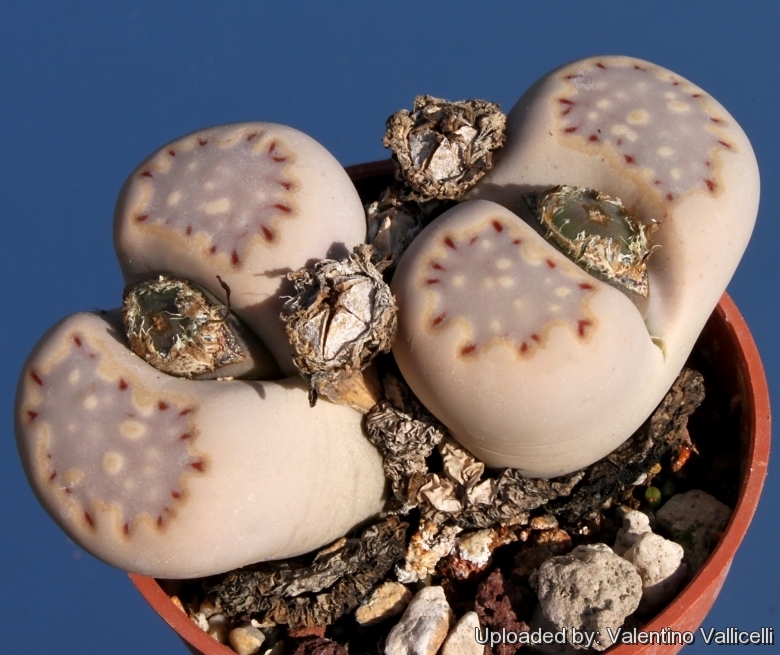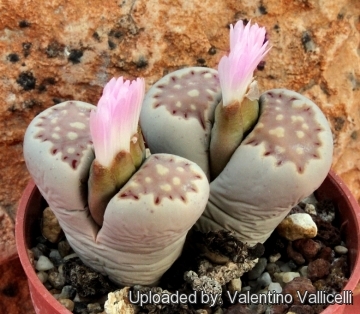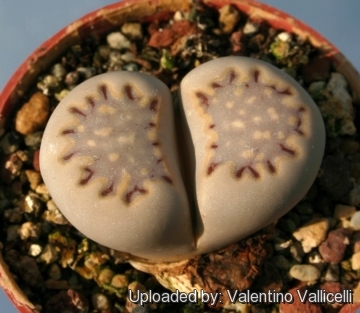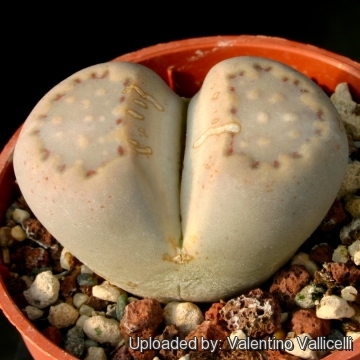Accepted Scientific Name: Lithops julii subs. fulleri
Natl. Cact. Succ. J. 31 (3) 59 [Set. 1976]

Lithops julii subs. fulleri C062 Near Kakamas, South Africa Photo by: Valentino Vallicelli
Origin and Habitat: Locality 65 km North West Springbok, South Africa.
Synonyms:
See all synonyms of Lithops julii
back
Accepted name in llifle Database:Lithops julii (Dinter & Schwantes) N.E.Br.Gard. Chron. 1926, Ser. III. lxxix. 102.Synonymy: 19
Accepted name in llifle Database:Lithops julii subs. fulleri (N.E.Br.) B.FearnNatl. Cact. Succ. J. 31 (3) 59 [Set. 1976]Synonymy: 29
- Lithops julii subs. fulleri (N.E.Br.) B.Fearn
- Lithops julii subs. fulleri var. brunnea de Boer
- Lithops julii subs. fulleri var. brunnea C179 TL: 10 km NE of Pofadder, South Africa
- Lithops julii subs. fulleri C024 5 km N of Kenhardt, South Africa
- Lithops julii subs. fulleri C056 25 km SW of Pofadder, South Africa
- Lithops julii subs. fulleri C062 Near Kakamas, South Africa
- Lithops julii subs. fulleri C121 115 km W of Kenhardt, South Africa
- Lithops julii subs. fulleri C122 125 km W of Kenhardt, South Africa
- Lithops julii subs. fulleri C161 Near Pofadder, South Africa
- Lithops julii subs. fulleri C162A 70 km WSW of Pofadder, South Africa
- Lithops julii subs. fulleri C171 60 km W of Upington, South Africa
- Lithops julii subs. fulleri C203 15 km SSE of Kenhardt, South Africa
- Lithops julii subs. fulleri C230B 75 k
- Lithops julii subs. fulleri C259 40 km ENE of Gamoep, South Africa
- Lithops julii subs. fulleri C319 5 km NE of Pofadder, South Africa
- Lithops julii subs. fulleri C323 25 km SW of Upington, South Africa
- Lithops julii subs. fulleri C378 65 km NE of Springbok, South Africa
- Lithops julii subs. fulleri C416 E of Onseepkans, South Africa
- Lithops julii subs. fulleri var. rouxii (de Boer) D.T.Cole
- Lithops julii var. rouxii C215 75 km WSW of Warmbad, Namibia
- Lithops julii var. rouxii C216 60 km WSW of Warmbad, Namibia
- Lithops julii var. rouxii C217 70 km WSW of Warmbad, Namibia
- Lithops julii var. rouxii C324 55 km W of Warmbad, Namibia
- Lithops maughanii N.E.Br.
Cultivars
(3):
back
Description: Lithops juliiSN|12138]]SN|13037]] subs. fulleri is a very pretty distinct subspecies of the variable Lithops juliiSN|13037]]SN|13037]] sometime regarded as a separate species. It has shoulders, margins and islands light creamy greenish grey, margins edged with a light brownish-green, especially in the indentations. Windows and channels opaque greyish blue-green. Rubrications obscure dark red-brown. The rust-brown lines mainly between the lobes of the margin is a specific characteristic of this subspecies. Moreover subs. fulleri lacks the “lip-smears” which is a typical feature of the other subspecies.
Habit: It is a stemless small to medium sized species that grows solitary or forming clumps of 2 or up to 15 8or more) bodies.
Body (paired leaves): Cone-shaped, or obconic, elliptic in outline 25 mm high, 20-30 mm broad, and 16-20 mm thick, separated by a 5-12 mm deep fissure, dividing it into two contiguous, (usually) conjunct lobes; Faces slightly reniform usually flat, at times scarcely convex often rough from being covered with small bumps caused by numerous impressed dendritic markings. Margin smooth, light dove-grey with a slight violaceous tint; window large, dark-green; projections from margins into window raised above the level of the window surface and giving the top a rough appearance; projections forming at times numerous small islands of the same colour as sides, thereby dividing the window into small, more or less confluent areas; sometimes depressions between the ridges with interconnected impressed bright rust-brown lines making a very pleasing contrast, or at times the lines only to be seen between the short lobes of the inner and outer margins; inner and outer margins at times deeply lobed, lobes irregularly shaped. It is however very variable in colour, some specimens being opaque whitish-grey and almost uniform in colour, others opaque but strongly reticulated with fine impressed brown markings, yet others with largely open obscurely translucent windows.
Flowers: Single, white, daisy-like, emerging from the fissure and as large as the pair of fleshy leaves below.
Blooming season: From mid-summer through fall.
Fruit: Seed capsules-loculed, top flatted or slightly convex, faces elliptic.
Seeds: Yellow-brown to light yellow-brown.
Similar species: It is vaguely similar to Lithops karasmontanaSN|13037]]SN|12138]], but is readily distinguished from that species by its more crowded dendritic markings, rougher top, and different colouration, and these two species have nothing in common with one another.
Subspecies, varieties, forms and cultivars of plants belonging to the Lithops julii group
 Lithops julii (Dinter & Schwantes) N.E.Br.: Cole numbers: C063, C064, C183, C297, C349 (chrysocephala) C205; (littlewoodii) C218. The more distinctive feature of this plant is a brown 'lip-smear' along the inner margins. Three main forms have been proposed and were even given varietal status (“pallid”, “reticulated” and “fuscous”) but wild populations have all three of this forms variously intermingled. Distribution: Namibia
Lithops julii (Dinter & Schwantes) N.E.Br.: Cole numbers: C063, C064, C183, C297, C349 (chrysocephala) C205; (littlewoodii) C218. The more distinctive feature of this plant is a brown 'lip-smear' along the inner margins. Three main forms have been proposed and were even given varietal status (“pallid”, “reticulated” and “fuscous”) but wild populations have all three of this forms variously intermingled. Distribution: Namibia Lithops julii C063 60 km SE of Warmbad, Namibia D.T.Cole: extremely variable pattern.
Lithops julii C063 60 km SE of Warmbad, Namibia D.T.Cole: extremely variable pattern. Lithops julii C064 Near Karasburg, Namibia D.T.Cole: stunning network, variable.
Lithops julii C064 Near Karasburg, Namibia D.T.Cole: stunning network, variable.- Lithops julii C183 25 km SE of Warmbad, Namibia: open jagged pattern, variable.
 Lithops julii C205 (syn. chrysocephala) 50 km SE of Warmbad, Namibia: pale milky grey body.
Lithops julii C205 (syn. chrysocephala) 50 km SE of Warmbad, Namibia: pale milky grey body. Lithops julii C218 (syn. littlewoodii) TL: 40 km WSW of Warmbad, Namibia: pinkish jagged top.
Lithops julii C218 (syn. littlewoodii) TL: 40 km WSW of Warmbad, Namibia: pinkish jagged top. Lithops julii C297 45 km SE of Warmbad, Namibia: big light grey body, indented lines.
Lithops julii C297 45 km SE of Warmbad, Namibia: big light grey body, indented lines. Lithops julii C297A TL: 45 km SE of Warmbad, Namibia cv. Peppermint Crème D.T.Cole: Very distictive blue-green form derived from only one specimen collected by Leslie Pretorius in 1983 in Namibia. Margins and islands very pale milky bluish green and shoulders a little lighter than the margins. Lip-smears pale brownish green. Channels opaque pale milky bluish grey.
Lithops julii C297A TL: 45 km SE of Warmbad, Namibia cv. Peppermint Crème D.T.Cole: Very distictive blue-green form derived from only one specimen collected by Leslie Pretorius in 1983 in Namibia. Margins and islands very pale milky bluish green and shoulders a little lighter than the margins. Lip-smears pale brownish green. Channels opaque pale milky bluish grey.- Lithops julii C349 45km South-East of Warmbad, Namibia: pink grey with brown spots.
 Lithops julii subs. fulleri (N.E.Br.) B.Fearn: Cole numbers: C024, C056, C062, C121, C122, C161, C162A, C171, C203, C230B, C259, C319, C323, C378
Lithops julii subs. fulleri (N.E.Br.) B.Fearn: Cole numbers: C024, C056, C062, C121, C122, C161, C162A, C171, C203, C230B, C259, C319, C323, C378
This is an extremely variable subspecies in colour, pattern and rubrication. Shoulders, margins and islands light grey, often tinged with pink, yellow, blue or green, or beige. Windows and channels milky blue, pale pinkish, greenish or yellowish grey, or mauve, pink or rust-brown; often with a brown or dark greenish-brown smear thinly lining both inner and outer margins.- Lithops julii subs. fulleri var. brunnea de Boer: Cole number: C179 Very similar to var. fulleri, but browner in colour. Colours: Shoulders, margins and islands pale creamy, pinkish or bluish grey, or beige. Windows and channels greyish, reddish or greenish brown, or grey. Rubrications red.
 Lithops julii subs. fulleri var. brunnea C179 TL: 10 km NE of Pofadder, South Africa: browner in colour.
Lithops julii subs. fulleri var. brunnea C179 TL: 10 km NE of Pofadder, South Africa: browner in colour.- Lithops julii subs. fulleri C024 5 km N of Kenhardt, South Africa: deep furrows, red orange.
- Lithops julii subs. fulleri C056 25 km SW of Pofadder, South Africa: jagged milky center.
 Lithops julii subs. fulleri C056A 25 km SW of Pofadder, South Africa cv. Fullergreen D.T.Cole: Shoulders, margins and islands light creamy greenish grey, margins edged with a light brownish-green, especially in the indentations. Windows and channels opaque greyish blue-green. Rubrications obscure dark red-brown.
Lithops julii subs. fulleri C056A 25 km SW of Pofadder, South Africa cv. Fullergreen D.T.Cole: Shoulders, margins and islands light creamy greenish grey, margins edged with a light brownish-green, especially in the indentations. Windows and channels opaque greyish blue-green. Rubrications obscure dark red-brown. Lithops julii subs. fulleri C062 Near Kakamas, South Africa: indented lines.
Lithops julii subs. fulleri C062 Near Kakamas, South Africa: indented lines. Lithops julii subs. fulleri C121 115 km W of Kenhardt, South Africa: reddish grey.
Lithops julii subs. fulleri C121 115 km W of Kenhardt, South Africa: reddish grey.- Lithops julii subs. fulleri C122 125 km W of Kenhardt, South Africa: light tan-brown windows.
 Lithops julii subs. fulleri C161 Near Pofadder, South Africa
Lithops julii subs. fulleri C161 Near Pofadder, South Africa Lithops julii subs. fulleri C162A 70 km WSW of Pofadder, South Africa: handsome.
Lithops julii subs. fulleri C162A 70 km WSW of Pofadder, South Africa: handsome. Lithops julii subs. fulleri C171 60 km W of Upington, South Africa: pink brown with red lines.
Lithops julii subs. fulleri C171 60 km W of Upington, South Africa: pink brown with red lines.- Lithops julii subs. fulleri C203 15 km SSE of Kenhardt, South Africa: multicolored suffused windows.
- Lithops julii subs. fulleri C230B 75 k: orange pink, large windows.
- Lithops julii subs. fulleri C259 40 km ENE of Gamoep, South Africa: window with fine islands.
 Lithops julii subs. fulleri C319 5 km NE of Pofadder, South Africa: red dotted perimeter.
Lithops julii subs. fulleri C319 5 km NE of Pofadder, South Africa: red dotted perimeter. Lithops julii subs. fulleri C323 25 km SW of Upington, South Africa: coarse patterns.
Lithops julii subs. fulleri C323 25 km SW of Upington, South Africa: coarse patterns. Lithops julii subs. fulleri C378 65 km NE of Springbok, South Africa: brightly colored margin, pretty.
Lithops julii subs. fulleri C378 65 km NE of Springbok, South Africa: brightly colored margin, pretty.- Lithops julii subs. fulleri C416 E of Onseepkans, South Africa
 Lithops julii subs. fulleri var. rouxii (de Boer) D.T.Cole: Cole numbers: C215, C216, C217, C324 Strictly related to var. fulleri, but marked with stitch-like marginal rubrications. Margins with irregular indentations,and a distinctive series of dark rubrications which resemble stitches.
Lithops julii subs. fulleri var. rouxii (de Boer) D.T.Cole: Cole numbers: C215, C216, C217, C324 Strictly related to var. fulleri, but marked with stitch-like marginal rubrications. Margins with irregular indentations,and a distinctive series of dark rubrications which resemble stitches. Lithops julii f. fuscus: has mottled milky grey and dark brown top.
Lithops julii f. fuscus: has mottled milky grey and dark brown top.- Lithops julii var. littlewoodii de Boer: = Lithops julii
 Lithops julii pallid SB1344 Vrede, Namibia
Lithops julii pallid SB1344 Vrede, Namibia Lithops julii f. pallid: has pale milky grey bodies.
Lithops julii f. pallid: has pale milky grey bodies. Lithops julii var. reticulata Tischer ex de Boer: = Lithops julii has a noticeable reddish-brown network on the pearly top.
Lithops julii var. reticulata Tischer ex de Boer: = Lithops julii has a noticeable reddish-brown network on the pearly top. Lithops julii var. rouxii C215 75 km WSW of Warmbad, Namibia: grey-brown windows.
Lithops julii var. rouxii C215 75 km WSW of Warmbad, Namibia: grey-brown windows.- Lithops julii var. rouxii C216 60 km WSW of Warmbad, Namibia: window stitched with ochre.
 Lithops julii var. rouxii C217 70 km WSW of Warmbad, Namibia: soft grey window.
Lithops julii var. rouxii C217 70 km WSW of Warmbad, Namibia: soft grey window.- Lithops julii var. rouxii C324 55 km W of Warmbad, Namibia: marginal scratches.
 Lithops julii cv. Hot Lips
Lithops julii cv. Hot Lips
Bibliography: Major refences and further lectures
1) Heidrun E. K. Hartmann “Aizoaceae F – Z” Springer 2002
2) Achim Hecktheuer “Mesembs, mehr als nur Lithops” Books on Demand GmbH Norderstedt. 2008
3) Desmond T. Cole & Naureen A. Cole, Uwe Beyer, Yves Delange “Les Lithops” SUCCULENTES Spécial 2008 AIAPS (now Terra seca). 2008
4) Desmond T. Cole & Naureen A. Cole “LITHOPS Flowering Stones” Cactus & Co. Libri. 2005
5) Yasuhiko Shimada “The Genus Lithops” Dobun Shoin. 2001
6) Rudolf Heine “Lithops - Lebende Steine” Neumann Verlag. 1986
7) Bernd Schlösser “Lithops – Lebende Steine” Praktische Anleitung für die Zimmerkultur. BussinessPoint MEDIA. 2000
8) Steven A. Hammer “Lithops – Treasures of the veld” British Cactus and Succulent Society. 1999
9) Desmond T. Cole “Lithops – Flowering Stones” Acorn Books 1988
10) Rudolf Heine “Lithops – lebende Steine” Neumann Verlag. 1986
11) David L. Sprechman “Lithops” Associated University Presses, Inc. 1970
12) Gert Cornelius Nel “Lithops” Hortors Limited, South Africa 1946
13) Edgar Lamb "The illustrated reference on cacti and other succulents" Blandford Press. 1978
14) Christopher Brickell, Royal Horticultural Society "RHS A-Z Encyclopedia of Garden Plants: K-Z., Volume 2" Kindersley, 2008
15) G. C . Nel “Lithops: Plantae succulantae, rarissimae, in terra obscuratae, e famailia Aizoaceae, ex Africa australi” Hortors Limited, Cape Town, South Africa 1946
16) Heidrun E. K. Hartmann "Illustrated Handbook of Succulent Plants: Aizoaceae F-Z" Springer, 2002
17) Steven A. Hammer "Lithops: Joyaux du veld" Editions Quae, 25/nov/2010
 Lithops julii subs. fulleri C062 Near Kakamas, South Africa Photo by: Valentino Vallicelli
Lithops julii subs. fulleri C062 Near Kakamas, South Africa Photo by: Valentino Vallicelli Lithops julii subs. fulleri C062 Near Kakamas, South Africa Photo by: Valentino Vallicelli
Lithops julii subs. fulleri C062 Near Kakamas, South Africa Photo by: Valentino Vallicelli Lithops julii subs. fulleri C062 Near Kakamas, South Africa Photo by: Valentino Vallicelli
Lithops julii subs. fulleri C062 Near Kakamas, South Africa Photo by: Valentino VallicelliSend a photo of this plant.The gallery now contains thousands of pictures, however it is possible to do even more. We are, of course, seeking photos of species not yet shown in the gallery but not only that, we are also looking for better pictures than those already present.
Read More... Cultivation and Propagation: In the winter season the plant doesn’t need watering, the plant in this time extracts water from the outer succulent leaves, allowing them to shrivel away, relocating water to the rest of the plant and to the new leaves that form during this period. This plant is best for a well lit area (Bright shade to full sun). Water sparingly only when warm, no water when cold.













